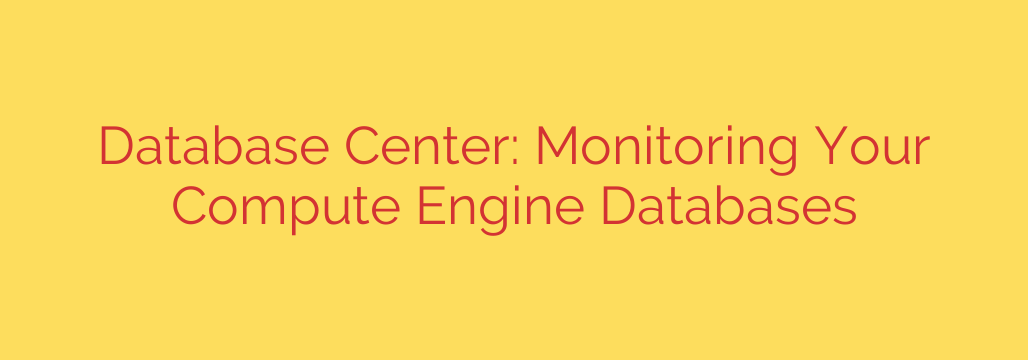
Mastering Database Monitoring on Compute Engine: A Unified Approach
Managing self-hosted databases like PostgreSQL, MySQL, and SQL Server on virtual machines offers incredible flexibility, but it often comes with a significant challenge: a lack of visibility. As your infrastructure scales, tracking the performance, configuration, and security of each database instance becomes a complex and time-consuming task. Hopping between individual VMs to check resource utilization or verify settings is inefficient and prone to error.
To truly optimize your database fleet, you need a centralized, comprehensive view. A unified dashboard that automatically discovers and monitors all your self-managed databases is no longer a luxury—it’s a necessity for modern cloud operations. This approach transforms database management from a reactive chore into a proactive strategy.
The Power of a Single Pane of Glass
The core problem with scattered database instances is the absence of a single source of truth. A centralized monitoring solution addresses this directly by providing a consolidated overview of your entire database estate running on Compute Engine instances.
This powerful dashboard offers several key advantages:
Automated Discovery and Inventory: Manually keeping a spreadsheet of your database instances is a recipe for outdated information. A modern monitoring system automatically scans your VMs to detect running databases. This eliminates manual tracking and maintains a real-time inventory of all your database instances, including their type and version.
Comprehensive Performance Metrics: Guesswork has no place in performance tuning. You need hard data. A unified view provides critical metrics for every database at a glance. Gain instant insights into CPU, memory, and storage utilization to proactively address performance bottlenecks and plan for future capacity needs. This allows you to see which instances are under-resourced and which are over-provisioned, helping you optimize costs.
In-Depth Configuration Insights: Is every instance of your PostgreSQL database running the correct version? Are critical configuration flags set consistently across your fleet? Answering these questions manually is tedious. A centralized dashboard allows you to ensure consistency and proper configuration across your entire database fleet by easily viewing versions and specific settings.
Enhancing Security and Compliance Posture
Beyond performance, security is a paramount concern for any database administrator. A fleet-wide view is instrumental in identifying and mitigating potential vulnerabilities before they become serious problems.
By consolidating security-related information, you can quickly assess your overall risk posture. Key security insights include:
- Identifying Public IP Exposure: A database instance accidentally exposed to the public internet is a major security risk. A monitoring dashboard can immediately flag any instances with public IP addresses, allowing for swift remediation.
- Monitoring Encryption in Transit: Ensuring data is encrypted between your application and the database is crucial. A unified system helps you identify and remediate critical security risks, such as databases that are accepting unencrypted connections.
- Streamlining Compliance: For organizations subject to regulatory compliance, proving that security best practices are being followed is essential. A centralized view provides the evidence needed to demonstrate proper controls are in place across your database environment.
Actionable Tips for Proactive Database Management
Having access to this data is the first step. The next is using it to drive intelligent decisions. Here are a few actionable tips for leveraging a centralized monitoring dashboard:
- Conduct Regular Fleet Reviews: Schedule time weekly or bi-weekly to review your database dashboard. Look for trends in resource utilization, identify newly discovered instances, and check for any configuration drift.
- Prioritize Security Alerts: Treat alerts for public IPs or unencrypted connections with the highest priority. These represent immediate and significant risks that need to be addressed right away.
- Use Performance Data for Capacity Planning: If you notice a database consistently running at high CPU or memory utilization, it’s a clear signal that it may need more resources or query optimization. Use these trends to plan for future growth before performance degradation impacts your users.
- Standardize Your Configurations: Use the configuration view to identify databases running on outdated versions or with non-standard settings. Create a plan to standardize your fleet to improve manageability, security, and performance.
Ultimately, moving from manual, instance-by-instance checks to a unified, fleet-wide monitoring strategy is a fundamental step toward mastering your self-managed databases on the cloud. It provides the visibility needed to optimize performance, strengthen security, and manage your infrastructure with confidence.
Source: https://cloud.google.com/blog/products/databases/database-center-expands-coverage/








